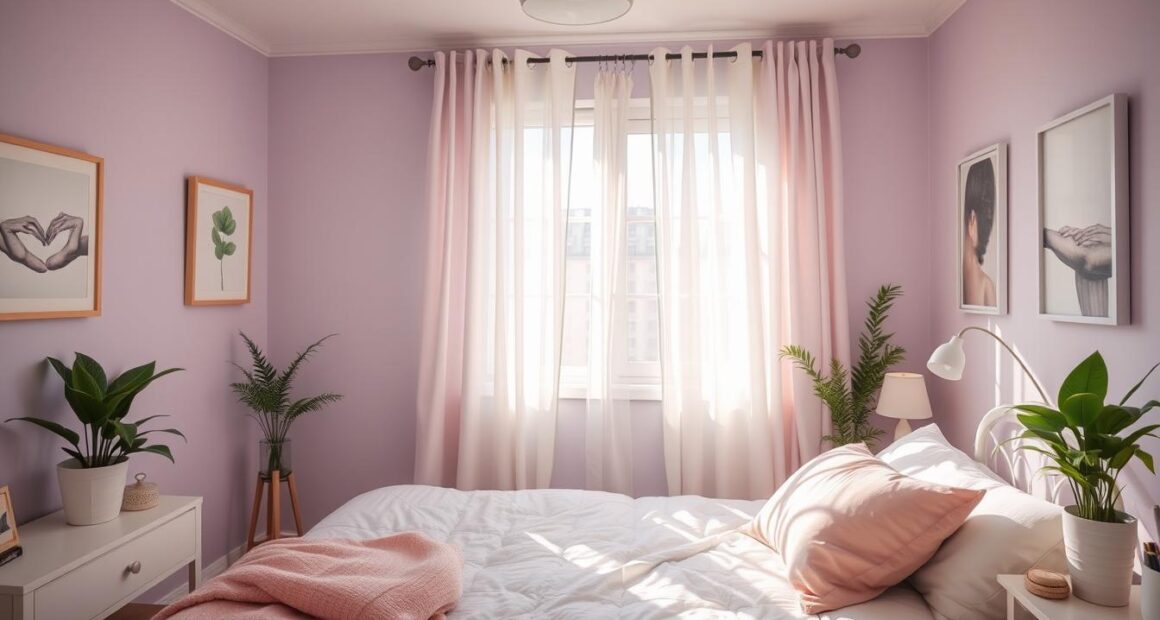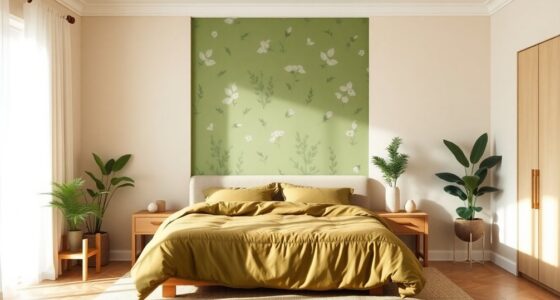Ever entered a place and felt a change in your mood? Maybe a room with sunny yellow made you feel energetic. Or a cozy blue corner might have calmed you down. The colors around us can deeply affect how we feel.
Choosing colors for your bedroom sets its feel and changes your mood too. Colors can make your bedroom a place for rest or excitement. Research shows colors influence our emotions. This can make your bedroom a space for healing or peace.
Think about the effect of your bedroom’s colors on your sleep and feelings. This article will explore how colors in the bedroom can change how we feel. Let’s find out how the right color can transform your space.
Key Takeaways
- The choice of bedroom colors can significantly affect your mood and overall well-being.
- Colors like blue promote calmness, while yellow can energize—or frustrate—depending on the shade.
- Soft pinks and serene greens offer nurturing environments that aid relaxation and rejuvenation.
- Understanding how different hues interact with your emotions can guide your decor choices.
- Creating the right ambiance with color can improve your sleep quality and mental health.
- Experimenting with color under varying lighting can help you find the right balance for your space.
The Impact of Color on Your Mood
Color psychology is key in how we feel in various spaces. Each color evokes strong emotions, impacting our mood and well-being. By understanding color’s psychological effects, you can design spaces that reflect how you want to feel.
Understanding Color Psychology
Each color brings out specific feelings. Cool shades like blue and green calm us, lowering respiration and blood pressure. Meanwhile, vibrant colors like yellow boost mental and physical energy. However, certain yellows can make us uneasy. This shows how color affects us differently.
How Colors Interact with Emotions
Colors deeply influence our emotions. Red, for instance, can excite us by raising our heart rate. Soft blues bring calm and peace. Pink can stir positive feelings and spur creativity. Choosing colors wisely can greatly improve your mood.
Choosing the Right Color for Your Bedroom
Finding the perfect color for your bedroom is a thoughtful process. It’s all about matching the color with your personality and how you live. Using a color assessment guide can make it a lot easier. It’s key to know what you like to make your bedroom feel just right for you.
Assessing Your Personality and Lifestyle
Consider how your daily life and sleep habits might shape your color choice. Here are a few questions to think about:
- Do you love rooms with bright colors or prefer calm, muted shades?
- Think about the mood you want. Do you need a peaceful place or something to wake you up?
- Your family’s needs matter, too. Kids might enjoy fun colors, while adults often choose relaxing ones.
Questions to Guide Your Choice
Thinking over these questions will help you pick better. Knowing your personal style lets you find colors that feel like “you.” Trends are tempting, but classics last longer and please more. Use tech, like color visualizing apps, to see how colors look in your space.
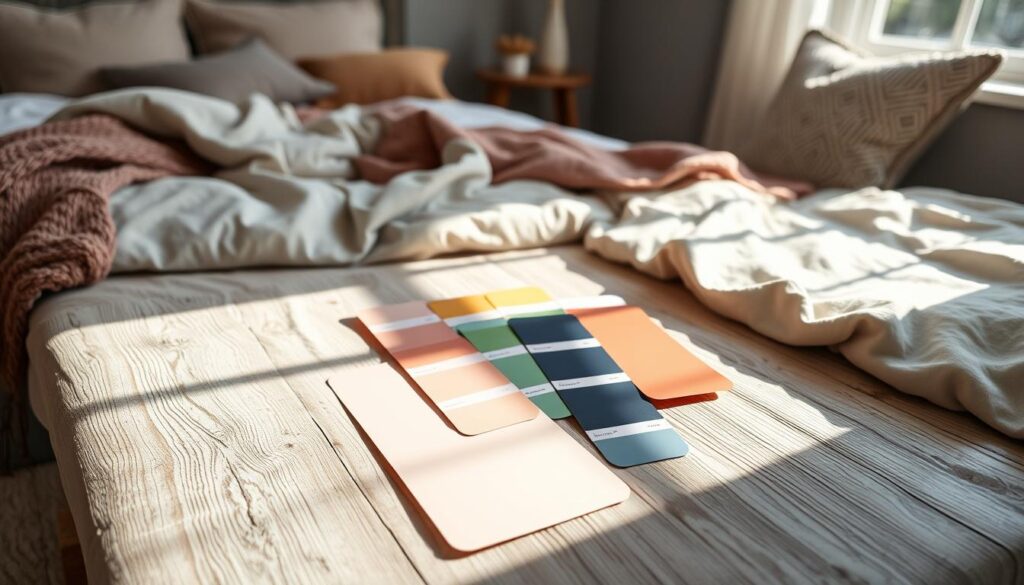
| Color | Personality Trait | Lifestyle Suitability |
|---|---|---|
| Chartreuse | Lively | Bright, energetic spaces |
| Peachy Pink | Adaptable | Versatile settings |
| Muted Green (Sea Salt) | Calm | Serene atmosphere |
| Warm White (Pointing) | Versatile | Complementing various furnishings |
| Soft Blue (Summer Shower) | Tranquil | Child-friendly spaces |
Neutralizing White: A Versatile Choice
In the world of interior design, neutral bedroom colors like white stand out. They are highly versatile. White acts as a base color that fits many decorating styles easily. Picking the right white shade makes a big difference in your space’s look and feel.
Benefits of Neutral Colors
Choosing white is about more than just looks. It offers several benefits:
- Illusion of Space: Light neutrals can make small rooms appear bigger.
- Design Flexibility: Whites and neutrals let you change your decor easily without conflict.
- Sophistication: White brings an elegant touch, making any bedroom look classy.
- Light Enhancement: White enhances natural light, making spaces brighter and livelier.
- Contrast Creation: Mixing off-white with bright whites makes for a lively contrast.
Decorating with White
Utilizing white effectively can be done through these decorating tips:
- Use different white shades to keep things interesting. ‘Fuji’, a warm white, goes well with cooler tones.
- Add textured throws and pillows in neutral colors. They add depth while keeping the vibe calm.
- An accent wall in a trendy neutral like taupe or green-grey can spice up white walls.
- Choose furniture in white or soft beige. These colors work together to warm up the room subtly.

Serene Blue: The Color of Calm
Blue is a top choice for making your bedroom a peaceful place. Its calming effects are known for bringing peace and helping you relax. This color can lower heart rates and blood pressure. It makes an ideal setting for a good night’s sleep. Having the right shades of blue can make your bedroom a calming space to relax after a busy day.
How Blue Reduces Stress
Studies link blue’s calming effects to feelings of comfort and joy. Rooms painted blue can help you sleep better, say experts. Seeing these benefits, many choose soft blues like Sky Blue for a peaceful room.
Best Shades of Blue for Bedrooms
There are many blue shades that suit different styles and preferences. Light blue mixed with white and silver feels fresh and light. Baby Blue, Pale Blue, and Sea Salt Blue work well with many looks, from coastal to Scandinavian. Calming blues like Dew Drop and Astral Blue can make small rooms feel bigger.
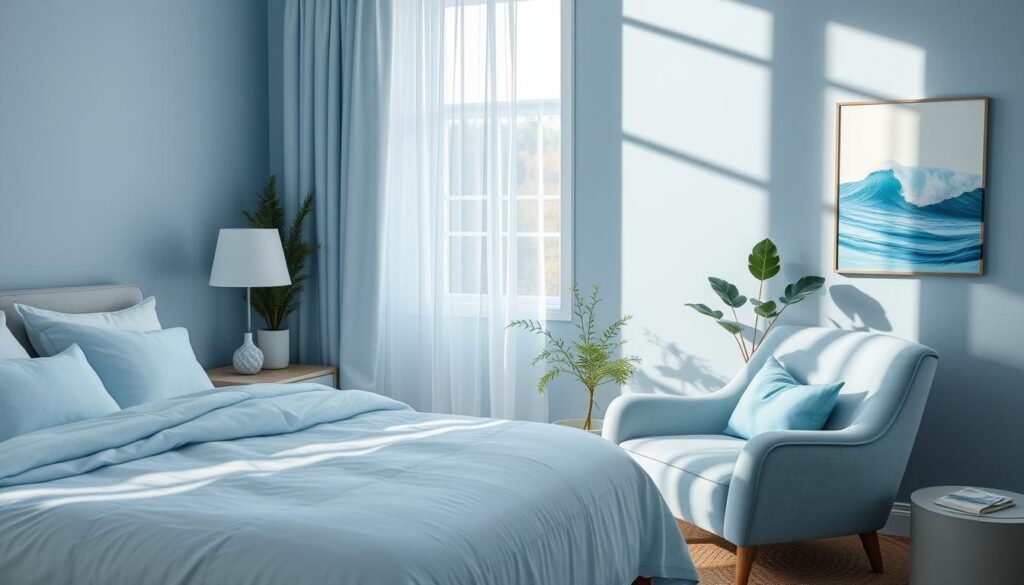
Blue’s versatility means it easily fits with your room’s look, making it a classic choice. Whether you pick a medium tone like Stargazer or a light one like Hyacinth Tint, serene blue shades are still popular for creating relaxing spaces.
Energetic Red: Stimulating Passion and Activity
Red is full of life and passion, a favorite for sprucing up spaces. It brings a rush of energy and joy, ideal for a lively beginning to the day. By carefully adding red touches, a room becomes more inviting without being too much.
Using Red as an Accent
Adding red highlights is a great way to bring in energy without taking over. Think about a feature wall or red items like pillows and art. These touches can spark conversations and creativity, making your bedroom feel more alive.
Creating a Balanced Energy
To keep your room feeling right, mix red with softer colors. This combination offers a bold contrast and cools down red’s fire. Pairing red with gentle blues or greens makes for a cozy yet energizing space. It’s the perfect setup for relaxing after busy days.
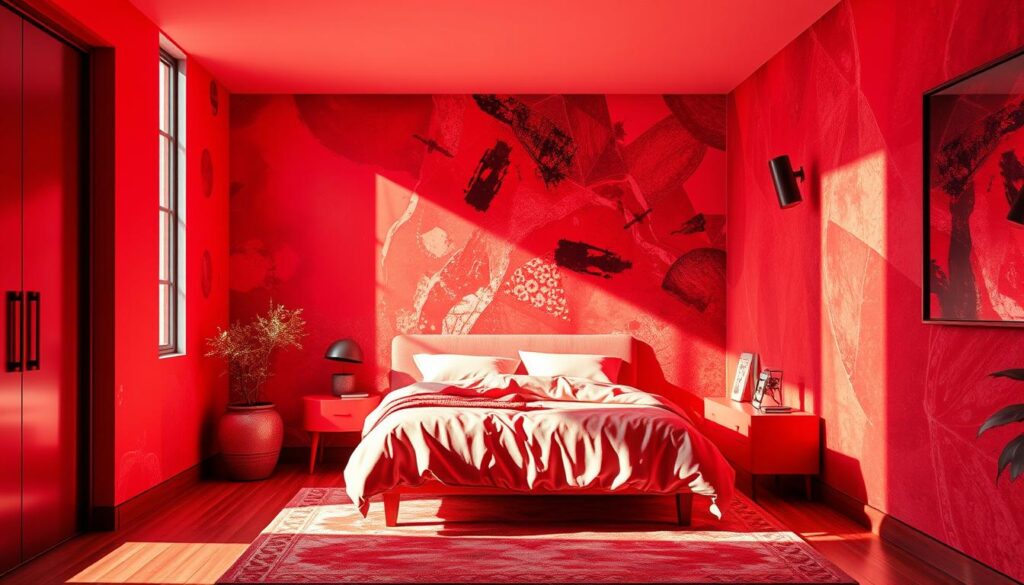
| Color | Effects | Best Use |
|---|---|---|
| Red | Stimulates passion, energy | Accent pieces, gathering spaces |
| Soft Blue | Promotes calm, relaxation | Bedrooms, bathrooms |
| Muted Green | Aids balance, renewal | Living rooms, offices |
| Yellow | Enhances conversation, optimism | Social spaces, kitchens |
These color ideas help you enjoy red’s vibrant vibes while keeping your bedroom serene. Try out different mixes to find what fits you best.
Uplifting Yellow: A Bright Start to Your Day
Yellow is a bright and happy color. It reminds us of the sun and brings joy. Using yellow in your bedroom can make you feel good every morning. It’s great for those who love a sunny room. Yellow makes a space feel welcoming without being too much.
Understanding the Positive Effects of Yellow
Studies show yellow makes people feel more upbeat and energetic. It’s a top pick for places where we hang out. Light yellows can make a room seem bigger, similar to light or neutral colors. In the bedroom, yellow helps people wake up feeling refreshed.
For rooms with less sunlight, yellow can make them brighter. A survey shows 68% of designers think yellow works well in such rooms. Adding a yellow wall can also lessen grogginess in the morning. This was noted in a study where 74% felt more alert.
Light and soft yellows are favorites among homeowners. About 53% prefer these shades because they go well with different furniture. Yellow paint sales jump by 30% in spring, showing its popularity. And 82% say yellow in their homes boosts their mood, adding warmth and life.
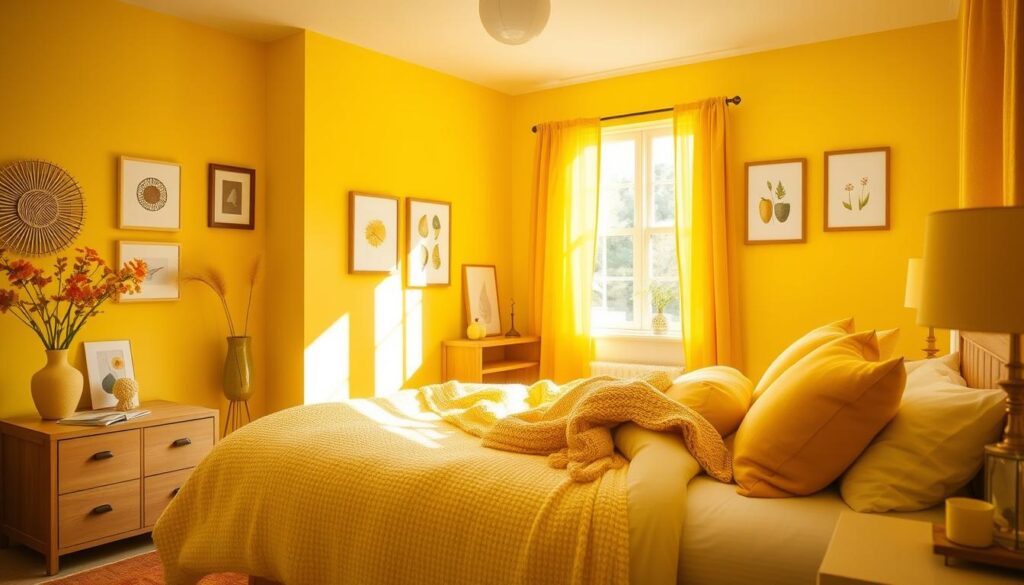
Yellow does more than just brighten a room. It transforms it into a cozy and happy place. From warm shades for a snug feel to light pastels for openness, yellow improves your room’s look and mood. It makes mornings more energetic and creates a calming space.
Soothing Green: Nature’s Touch for Relaxation
Designing a nature-inspired bedroom? Green colors are key for a serene haven. They bring the peace of the outdoors inside. Sage and light pistachio shades lower stress, making your space a restful escape.
Why Green Works Well in Bedrooms
Green shades make bedrooms peaceful. They offer a calm setting to relax at day’s end. Sage green blends nature with elegance, creating a tranquil yet stylish space.
Promoting Togetherness with Green
Green hues in a shared bedroom enhance unity. They make the room welcoming, encouraging family time. Sage green bedding or curtains beautify and invite, boosting the room’s charm.

Restful Purple: For Serenity and Luxury
Soft purples, like lavender and lilac, make your bedroom inviting and calm. These colors help you relax after a busy day. They turn your room into a peaceful place, helping you sleep better.
Soft Purples for a Calming Effect
Soft purples bring a sense of spirituality and luxury. Light lavender or muted lilac lifts your mood. They create a calm place that helps you escape daily stress. Combine these purples with neutrals or warm colors for a balanced look. Try these decor ideas:
- Use soft purple bedding to create an inviting centerpiece on your bed.
- Incorporate lavender curtains for a delicate touch that filters light beautifully.
- Add accent pillows in varying shades of purple to enhance visual interest.
Using Darker Shades for Sophistication
Darker purples, like plum or eggplant, add sophistication. They keep your bedroom feeling luxurious. Balance them with lighter shades. This prevents the room from feeling too heavy. Use dark purples as accents to add depth. Consider these tips:
| Color Type | Effect | Design Tip |
|---|---|---|
| Soft Purple | Calming, uplifting | Layer with warm neutrals |
| Darker Purple | Sophisticated, luxurious | Use as an accent on walls or furnishings |
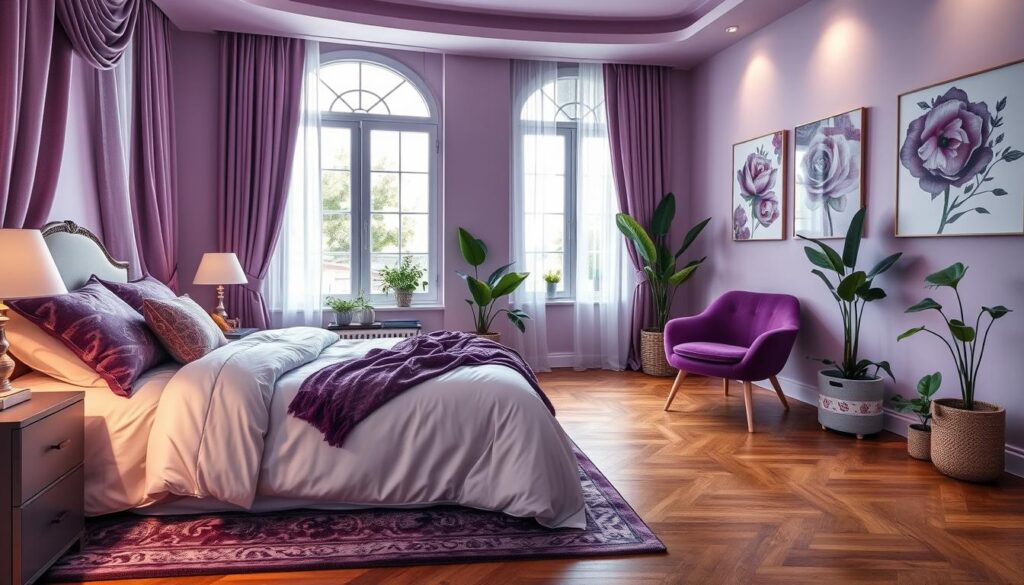
Exciting Orange: Energizing Your Mornings
Orange makes your bedroom exciting and energized, perfect for waking up. It’s vibrant and can lift your mood right away. But, using too much orange can be too much. It’s great as an accent color, bringing warmth and happiness.
Pairing Orange with Other Decor
When using orange in decor, mix it with colors that balance it out. Peach or terra cotta can be paired with whites or grays. This mix keeps the room welcoming and not too intense. Here are ways to add orange to your space:
- Use orange as an accent color on chairs or throw pillows.
- Select geometric wallpaper featuring orange tones to refresh minimalist spaces.
- Paint an accent wall or ceiling in a bold orange shade to create a chic focal point.
- Incorporate textures such as velvet in shades like “Citrus Orange” to enhance warmth.
- Combine multiple patterns while using orange to embrace a bold decor style.
Best Shades of Orange
Different orange shades can give your bedroom a unique feel. Benjamin Moore has a palette with “New Dawn 133” and “14 Carrots.” These shades meet various design needs. Popular dynamic shades of orange include:
| Shade | Description |
|---|---|
| Party Peach | A soft, uplifting shade for a cheerful atmosphere. |
| Startling Orange | A vibrant, attention-grabbing hue perfect for lively accents. |
| Orange Burst | Dynamic and invigorating, it works well in bold decor choices. |
| New Dawn 133 | A subtle peach tone that invites warmth without overwhelming. |
| Citrus Orange | A saturated hue ideal for creating energetic environments. |

Grounding Black: A Powerful Accent
Black adds sophistication and elegance to bedroom decor. It stands out when mixed with lighter shades. Black decor boosts the room’s vibe and grounds color schemes for a modern, refined look. It creates a striking contrast, making the space both stylish and welcoming.
Balancing Black with Light Decor
Using black accents lets you mix things up in the bedroom. When mixed with light colors, black adds depth and interest. Here’s how to balance them:
- Frames and Fixtures: Black frames for art or mirrors can lift the room’s look without taking over.
- Furniture Choices: Choose black pieces like nightstands or dressers. They act as solid anchors among soft tones.
- Textiles: Add black in bedding or throw pillows. It keeps the look together and adds comfort.
- Accent Walls: A black accent wall can set the tone, providing a chic background for lighter decor.
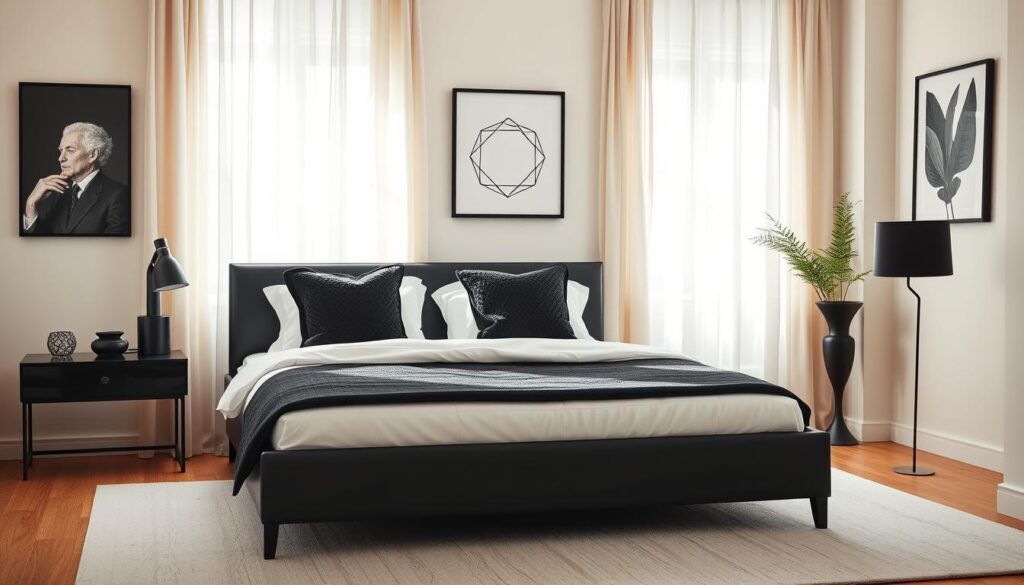
Calming Pink: The Essence of Tenderness
Soft pink in bedrooms can make you feel tender and happy. It creates a peaceful space for rest and positive feelings. Pink’s calming effects are known to reduce anger and aggression by 20-30%. This makes pink perfect for turning a bedroom into a soothing retreat.
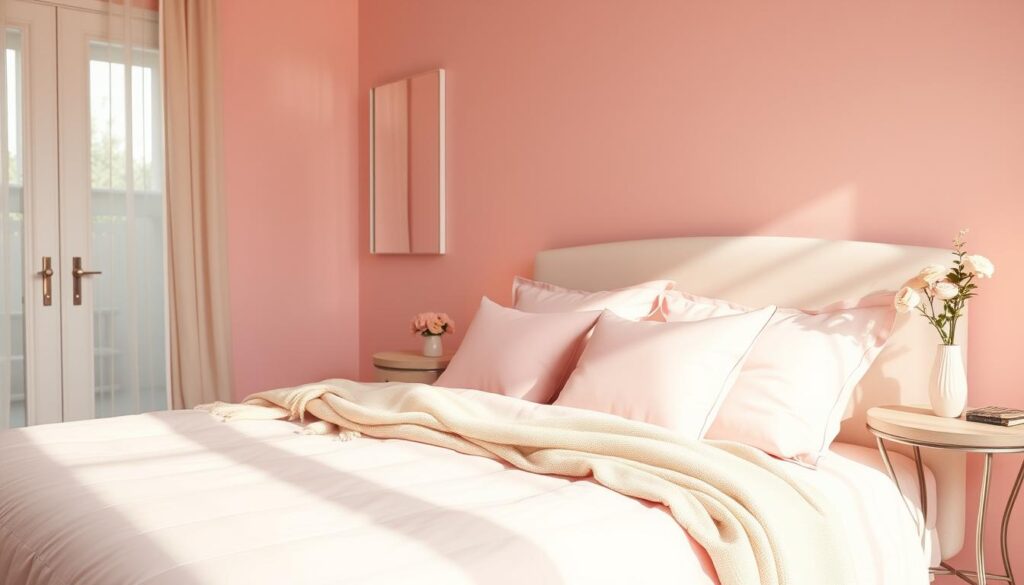
Exploring the “Pink Effect”
Pink does more than look pretty. It makes rooms feel warm and caring. That’s why it’s great for places where people heal emotionally, like counseling rooms. With soft pink tones, your room can become a space for self-care and emotional healing. Pink brings love and kindness into every room, whether it’s just for you or for everyone.
Studies have shown that pink environments can make people feel better 30% faster, especially in places meant for healing. Pastel or blush pink is really good at making spaces feel less stressful. Pink is linked to love and bonding during special moments and family gatherings. It invites you to enjoy its caring vibes.
Peaceful Gray: The Zen Choice
Gray tones can make your bedroom a calm place. This color is not only peaceful but also matches well with many designs. It can give your room a zen feel, making it seem bigger and more relaxing.
Creating Space with Pale Grays
Pale grays help make your room feel open. These shades let in light, making the space airy. Using less dark colors keeps the mood serene, perfect for relaxation.
Balance with Muted Colors
Mixing in muted colors with gray can look really nice. Try adding soft green or beige for a balanced look. This mix keeps the calm vibe of gray and adds warmth. You get a space that feels good and looks great.
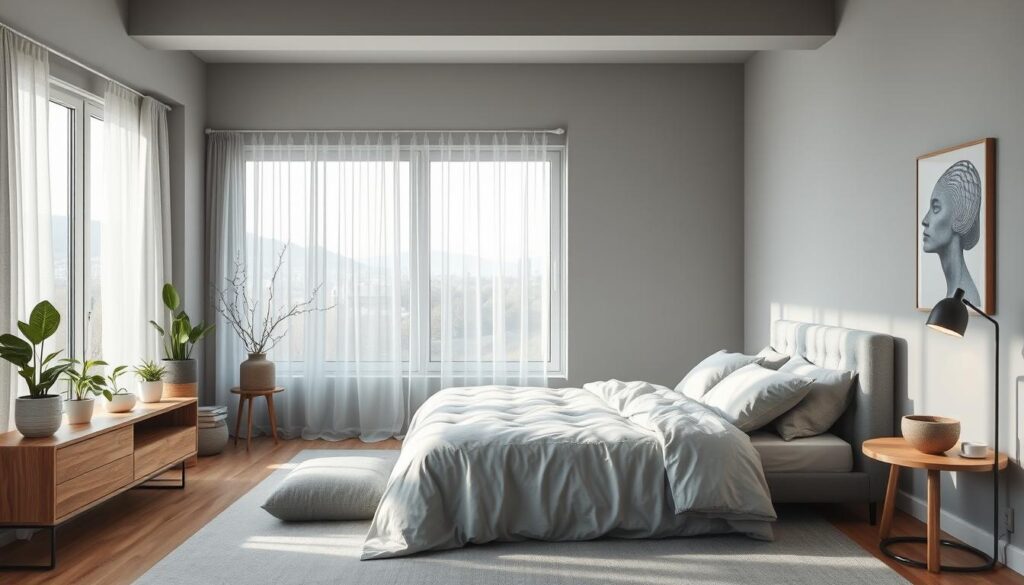
| Color | Effect | Best Pairings |
|---|---|---|
| Pale Gray | Enhances spaciousness | Light Woods, Soft White |
| Muted Green | Promotes serenity | Gray, Beige |
| Darker Gray | Adds sophistication | Pastels, Natural Textures |
Gray creates a zen space, perfect for your bedroom. By picking the right shades and decor, you can make a soothing escape. This helps you relax and think clearly.
Understanding Bedroom Colors and Moods
Thinking about your bedroom’s feel? Knowing how colors affect emotions can change how you feel in it. Different colors can make us feel calm or excited. Learning about these effects can help you make your bedroom feel just right.
Summary of Color Associations
Here’s what different colors do to our mood:
| Color | Association | Mood Impact |
|---|---|---|
| Bright Yellow | Stimulation and Energy | Can be uplifting but may lead to overstimulation |
| Blue | Calmness | Reduces stress and promotes relaxation |
| Green | Nurturing | Calming and linked to fertility |
| Purple | Creativity vs. Sadness | Lighter shades inspire creativity; deeper shades may evoke sadness |
| Orange | Energy | Darker shades calm; brighter variations can be overstimulating |
| Black | Dramatic | May induce feelings of claustrophobia when overused |
| Pink | Calming | Soft tones can reduce aggressive behavior |
| Gray | Neutral | Effects vary with combinations; can appear elegant or dreary |
Choosing Based on Your Mood Goals
Want to change how your bedroom makes you feel? Select colors based on your mood targets. Soft blues and greens for peace, or bright yellows and oranges for energy. Think about how colors can make your daily mood better. Make your space mirror the feelings you want, using colors that harmonize with your desires.
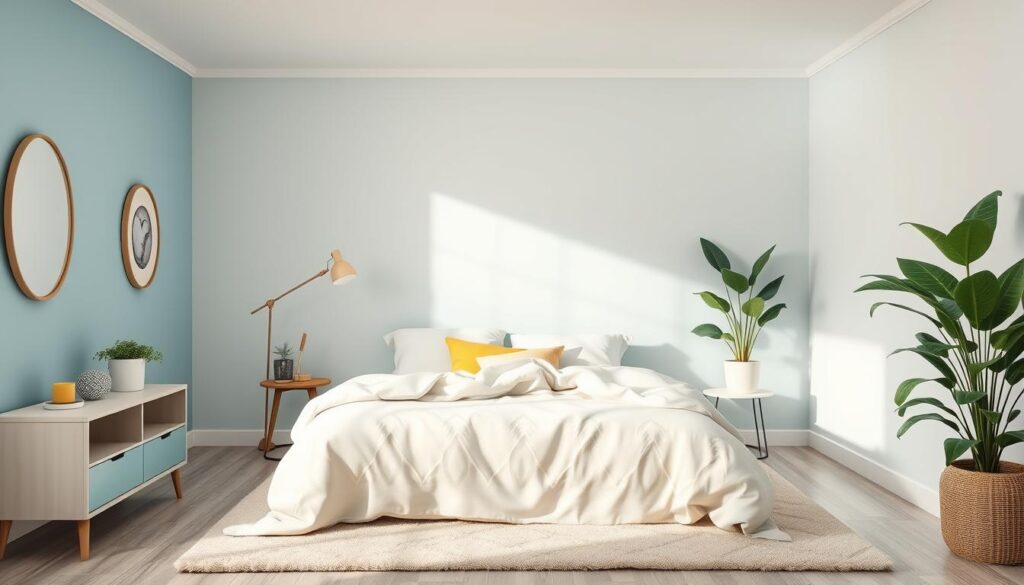
Conclusion
Choosing the right colors for your bedroom is key to creating the perfect atmosphere. Every color makes us feel different emotions. This can majorly help your relaxation and well-being. Whether it’s the calming effect of cool blues and greens or the warmth of peach and pink, picking the right colors can turn your bedroom into a personal retreat.
Studies show how colors affect our sleep and mood. For example, blue can calm your heart rate and help you sleep better. Lavender helps reduce stress and makes for a peaceful place to rest. It’s also smart to mix in neutrals like white, grey, and beige. This keeps your bedroom feeling open, yet still letting pops of color shine through.
The goal is to pick colors that mean something to you. Knowing why certain shades make us feel a certain way can help you design not just a pretty space but one that’s good for your mind and soul. The right colors in your bedroom can boost your creativity, help you relax, and refill your energy.
